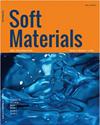Tannic acid-crosslinked chitosan matrices enhance osteogenic differentiation and modulate epigenetic status of cultured cells over glutaraldehyde crosslinking
IF 1.4
4区 材料科学
Q4 MATERIALS SCIENCE, MULTIDISCIPLINARY
引用次数: 6
Abstract
ABSTRACT Tannic acid (TA) is a polyphenol with potential to crosslink biomacromolecules. Though, feasibility of TA crosslinking is known, the more toxic glutaraladehyde (GA) continue to be used extensively for developing novel chitosan-based scaffolds, hindering in vivo translation. Thus, a direct comparison between TA- and GA-crosslinked chitosan membranes with respect to physico-chemical, biocomptability and biofunctional properties is required. Role of TA to modulate epigenetic changes in cultured cells is also investigated. TA-crosslinked scaffolds differed from GA in contact angle and swelling by 20–25% while mechanical properties and degradation differed by 50%. Cell viability on TA-crosslinked scaffolds was ~1.4 times higher compared to GA-crosslinked samples, osteocalcin expression was two-fold higher and ROS and cox-2 expression was reduced by ~1.4 times (p < .01). TA crosslinking modulated epigenetic changes in cultured cells by evidencing global DNA hypomethylation. It is concluded that TA can provide a flexible scaffold with ability to modulate epigenetics and osteogeneticity.单宁酸交联壳聚糖基质通过戊二醛交联促进细胞成骨分化并调节细胞表观遗传状态
单宁酸(TA)是一种具有交联生物大分子潜力的多酚。虽然已知TA交联的可行性,但毒性更大的戊二醛(GA)继续被广泛用于开发新型壳聚糖基支架,阻碍了体内翻译。因此,需要对TA-和ga交联壳聚糖膜在物理化学、生物相容性和生物功能特性方面进行直接比较。还研究了TA对培养细胞表观遗传变化的调节作用。ta交联支架与GA的接触角和溶胀差异为20-25%,力学性能和降解差异为50%。ta交联支架的细胞活力比ga交联样品高1.4倍,骨钙素表达量高2倍,ROS和cox-2表达量降低1.4倍(p < 0.01)。TA交联通过证明整体DNA低甲基化来调节培养细胞的表观遗传变化。综上所述,TA可提供一种具有调节表观遗传学和成骨能力的柔性支架。
本文章由计算机程序翻译,如有差异,请以英文原文为准。
求助全文
约1分钟内获得全文
求助全文
来源期刊

Soft Materials
工程技术-材料科学:综合
CiteScore
2.90
自引率
0.00%
发文量
21
审稿时长
2.2 months
期刊介绍:
Providing a common forum for all soft matter scientists, Soft Materials covers theory, simulation, and experimental research in this rapidly expanding and interdisciplinary field. As soft materials are often at the heart of modern technologies, soft matter science has implications and applications in many areas ranging from biology to engineering.
Unlike many journals which focus primarily on individual classes of materials or particular applications, Soft Materials draw on all physical, chemical, materials science, and biological aspects of soft matter. Featured topics include polymers, biomacromolecules, colloids, membranes, Langmuir-Blodgett films, liquid crystals, granular matter, soft interfaces, complex fluids, surfactants, gels, nanomaterials, self-organization, supramolecular science, molecular recognition, soft glasses, amphiphiles, foams, and active matter.
Truly international in scope, Soft Materials contains original research, invited reviews, in-depth technical tutorials, and book reviews.
 求助内容:
求助内容: 应助结果提醒方式:
应助结果提醒方式:


